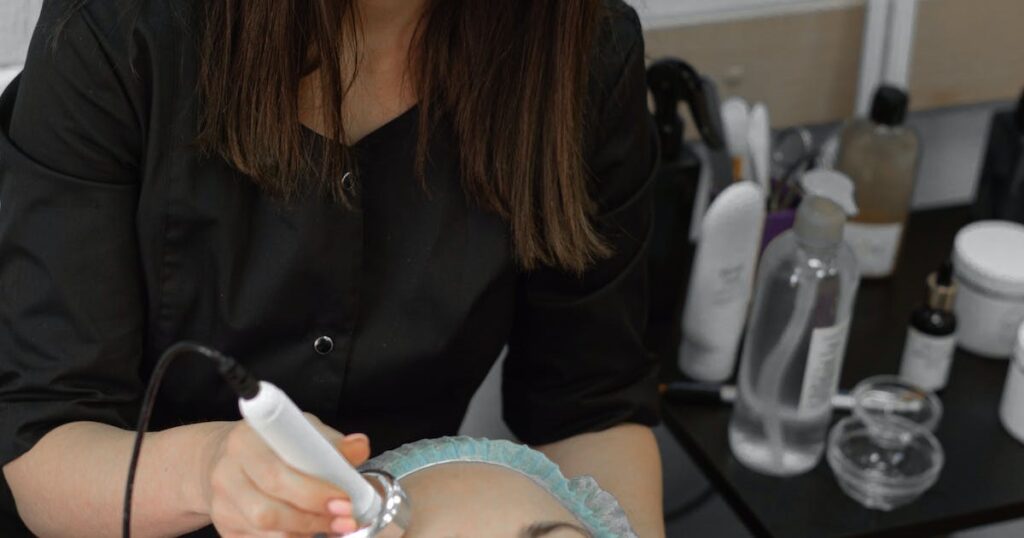
Laser hair removal is a safe and effective method of hair removal not only for aesthetic purposes, but also to correct hypertrichosis, that is, excess hair that can occur in some people with medical conditions, such as:
- Hormonal imbalances, especially increased testosterone or androgens.
- Taking medications, such as anabolic steroids and birth control pills.
- Polycystic ovary syndrome.
- Tumors that cause hormonal imbalances.
The most common form is laser hair removal, although pulsed light can also be used, both having very similar forms and functioning.
What is the difference between pulsed light and laser?
Intense pulsed light (IPL) is a broadband polychromatic light and the laser is an amplification of light by stimulated emission of radiation, this light being monochromatic, with a single wavelength. Pulsed light has, for these reasons, greater application and has several uses in the treatment of dermatological conditions.
The process through which the laser and pulsed light remove hair is, however, identical and is called photothermolysis. The intensity of light is consumed by melanin, that is to say, the hair shade. This makes the hair heat up with the end result of consuming and obliterating the follicle, the region that produces hair. To this end the interaction is more compelling on dull hair rather than fair complexion. Highly pigmented hair absorbs more heat and transmits it to the follicle, which is destroyed.
Is laser hair removal permanent?
No, this procedure is temporary. Most people need several sessions, six to eight, spaced out over months, so that they can start spacing out waxing more in time. After the first session, most people notice a 10 to 25% decrease in hair growth. After a few sessions, the hair takes months or even years to grow.
Laser hair removal is not permanent because it does not capture all the hair at the same growth stage. Furthermore, it is likely that some hair will grow back later, although thinner and weaker.
Can anyone have laser hair removal on any part of the body?
Laser hair expulsion should be possible on any piece of the body, except for the region around the eyes, as laser light can harm the eyes. In different regions of the body, laser hair evacuation is protected, for however long it is done by specific experts in consistence with all security rules.
As to laser hair evacuation, there are certain individuals for whom this methodology isn’t suggested:
- Pregnant women.
- People taking some medications, such as acne treatments.
- People with genital herpes (HSV-2) or who may develop cold sores.
- People prone to keloid scars.
- People who have or have had skin cancer.
- Areas of the skin with tattoos.
This procedure is more effective on people with dark, thick hair in contrast to light skin. The technology has been improved and is increasingly effective on dark-skinned people.
How should I prepare for laser hair removal?
In the weeks before the waxing sessions, you should avoid sunbathing or using a solarium in the areas to be waxed, as the more pigmented, the less effective laser hair removal may be.
Shaving should be done a few days before the sessions, as this procedure works well with thick hair roughly the size of a rice berry. Between sessions, waxing that pulls out hair, such as wax or household electric machines, should not be done.
At the place where the waxing will be carried out, the qualified professional must give the client protective glasses (which they must also wear) and clean the area of skin that will be waxed.
The procedure can take a few minutes or an hour, depending on the area to be treated and it is normal to feel some stinging during waxing. You may also notice a burning smell which is completely normal, as the hair is eliminated by the heat caused by light.
Can laser hair removal cause skin cancer?
There is no proven link between laser hair removal and skin cancer.
Does laser hair removal have side effects?
Laser hair removal rarely causes side effects. However, some people experience:
- Blisters, burns, swelling or scars.
- Herpes outbreaks.
- Hyperpigmentation or hypopigmentation, that is, some areas of the skin may become darker or lose pigment.
- Infections.
After a laser hair removal session, the skin that was treated may be more sensitive, red or sore. Cold compresses can be applied to the area to alleviate this sensation and sun exposure or artificial tanning methods should be avoided. The treated skin areas should always be protected with sunscreen in the weeks following the sessions.
Do home laser machines work the same?
Its operation is similar, but its power is lower, which means its effectiveness is also lower. Although the laser in these machines is less powerful, all safety instructions must be followed, namely, not using the machine on eyebrows, tattoos and the genital area (although it can be used on the groin).


